“Repurposing” a Livestock Guardian Dog doesn’t need to be stressful. If you have a plan and a backup plan, are prepared to be flexible with your expectations and have acquired the knowledge, understanding and patience to allow the livestock guardian dog to govern the pace of that process, you can be successful. Thank you to Kapsali Farm for sharing their own story of success.
“Kapsali Farm” is located in the Lower Hunter Valley of NSW, Australia. Our family of three, Peter, Lisa and our daughter Ada run a small pasture-raised chemical-free chicken business supplying local restaurants, cafes, and retail outlets with fresh eggs.
Once we had made the decision to proceed with the chicken enterprise we sought out expert advice covering all areas of production, marketing, soil, water, and general farm management. A recurring theme from our initial discussions with like-minded operators was that we needed to put in place a plan to keep the hens safe from predators, be it ground-based predators such as wild dogs and foxes or aerial predators such as eagles.
We were again and again encouraged to look at Livestock Guardian Dogs (LGDs), however, we had concerns about integrating such dogs into our family and being very conscious of our existing home dogs, two middle-aged much-loved Labrador Retrievers. We considered donkeys, geese, llamas, alpacas, guinea fowl, fencing options and even novel ideas like disco balls and fake owls. None of these options would provide the all-round protection we needed that we knew from our conversations, Livestock Guardian Dogs could provide.
It was around this time that we were chatting with our vet who immediately said to us “I’ve got the perfect lady for you” and later that week we had our first, and lengthy, discussion with Erin Williams about what we wanted to achieve. We had a basic understanding of obedience training from our companion dogs, but it became immediately apparent from the discussion with Erin that a Livestock Guardian Dog (“LGD”) was an entirely different ball game. They needed to bond with their charges; we couldn’t baby the LGD’s like we might a pet, and they each could adopt different approaches to their task depending on their breeding and nature. We started to feel totally overwhelmed. This wasn’t going to be like going to a breeder, picking out the cutest most loveable puppy and bringing it home to be doted upon by the family. But in our hearts, we knew that dogs were going to be what we needed.
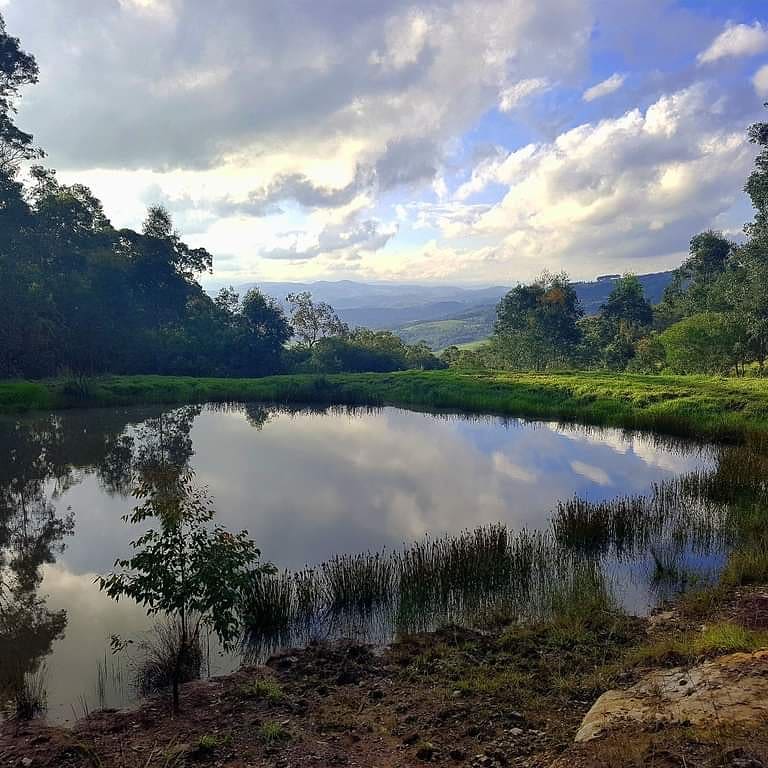
Our farm is not large by Australian standards, tiny in fact, it’s about 110 acres or 44 hectares. We live in a small valley with approximately 150 similar-sized properties, so some of our neighbours are quite close by and have their own animals – cows, sheep, chickens, dogs, horses, pigs, you know, your typical small farm holdings. Whilst this provides for a beautiful community it presents some challenges with respect to LGDs in terms of roaming or expanding their protected territory if given the opportunity.
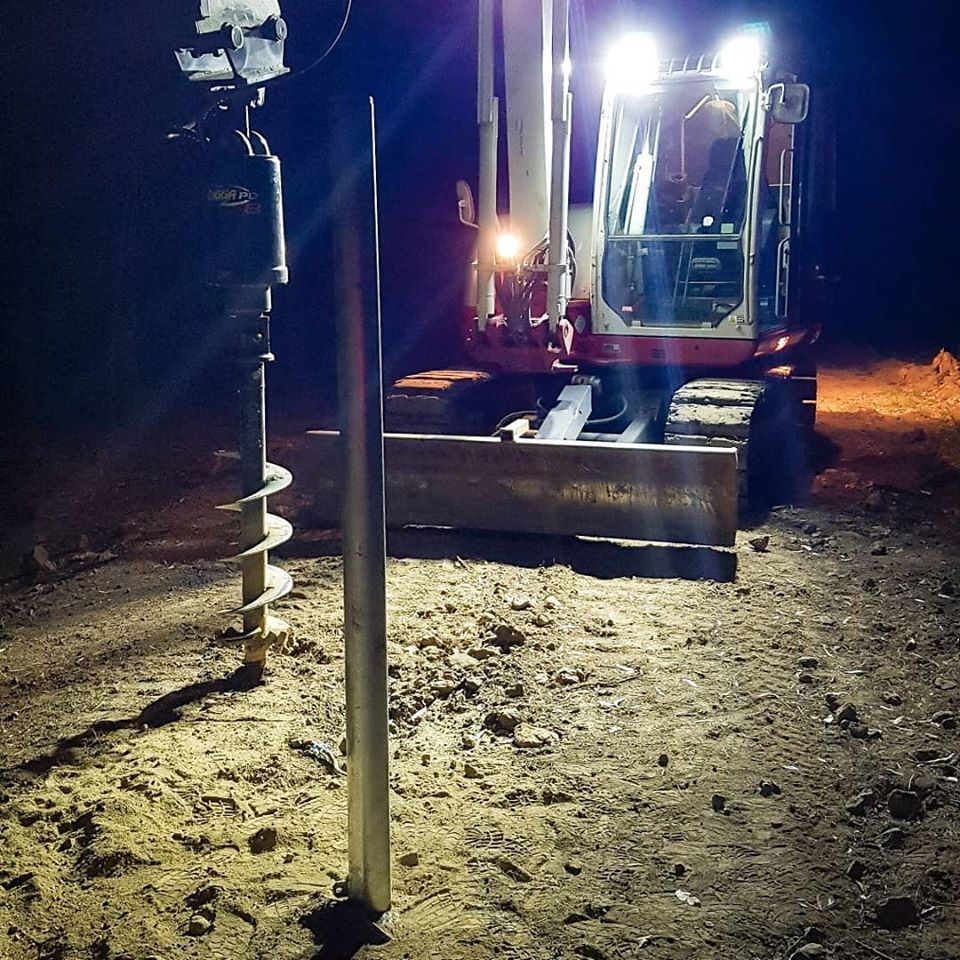
The pressure was on to complete the arduous installation of the 6ft high fence before the arrival of 600 hens and Kawa! The task was made difficult by the presence of rock over two-thirds of the ground to be fenced.
How on earth were we going to learn about running an egg business and all its idiosyncrasies when we had one or more dogs to worry about as well? Erin was clear on this from day one, we were going to need a good high fence – one that would keep the LGDs in and provide some assistance with keeping land-based predators out. Long story short, six months later we embarked on our first fencing project – ourselves – enclosing 35 acres with a 6ft high predator fence.
Meanwhile, we were on the lookout for a suitable Livestock Guardian Dog. The hens were going to arrive in a matter of months and we didn’t have a solution. We didn’t have the time to start with a pup, so we needed a mature dog. But with maturity can come risk, what was the dog’s background like? Would it bond with chickens? Would it adapt to its new environment? The list of “what-ifs” went on and on and on. Fortunately, we had Erin holding our hand during this process, someone to bounce ideas off, the good, the not so good and the outright crazy. Erin could always bring a level head to our discussions and plans. Something we realised from our first discussion with Erin was that this process would likely be more about training us, the humans, compared to the dog. If we got a dog with solid breeding, we could be almost guaranteed the traits for them to be a successful LGD would be there.
Our valley has a large escarpment on its western side which is a well-trodden thoroughfare for wild dogs. A neighbour had experienced numerous issues with wild dogs until he introduced an Anatolian Shepherd Dog to his operation, at which time the issues stopped. So of course, if it worked down at our neighbours, surely any Anatolian would work for us, right?
Erin encouraged us not to focus on a particular LGD breed and instead, try to find an experienced working dog and even better if that dog had experience with chickens, with solid breeding and a stable temperament. The hunt was on and Peter found an Anatolian breeder – “Tribocie Anatolian Shepherd Dogs” looking to re-home one of their dogs that wasn’t entirely working out in her current situation. Fortunately, she was located on a similar sized property only an hour away.
A few weeks later after we’d spoken with the breeder and the dog’s owner the three of us went along to meet Kawa, a three and bit-year-old Anatolian. It was your classic re-homing situation, she gave us that “look” and we were pretty much sold. So we got on the phone to Erin, very excited (I’m sure she was thinking “have they not listened to me at all!”), but with some hesitation, for a whole host of reasons, she agreed it was worth giving it a go. Kawa had been bonded with goats so should have had some good guarding tendencies. Kawa’s general demeanour seemed strong from videos we shared with Erin and she had a clean bill of health from the vet.
So how do we take a dog that has been in an enclosure for the past few months and bonded to goats and turn her into a suitable guardian of 600 hens? Erin suggested we get her a few chickens for her existing enclosure and we do some initial bonding/familiarisation work. We had the full support of Kawa’s owner at the time as she wanted the best outcome for everyone as well. Erin constructed a plan that could be implemented by her current owner to prepare Kawa for the transition to our chicken farm. This involved having the hens nearby, then in the same enclosure with a fence between, then in the same enclosure, building up to more and closer contact between dog and chickens. This went swimmingly for the first week or so, then we (the humans) got a bit too bold and left them together a little longer than usual, admittedly with a muzzle on Kawa…..a few hours later, one hen was missing and Kawa had a full belly…..we panicked a little, but Erin said “one step forward, two back” so we continued back on the program. A few weeks passed and the other hens remained unharmed.
Our new flock of 600 hens arrived on 21 December 2018. Bang on Christmas … nothing stressful about that!! The predator fence wasn’t quite finished so Kawa couldn’t come that same day. We did, however, have an electric net fence around the hens to assist with land-based predators. Peter camped out with the girls for about 10 days in total, seven of which were before Kawa arrived. During this time we had one wild dog to deal with and several eagle attacks. The eagles were especially stressful to deal with. The Australian Wedge Tail Eagle has an approximate wingspan of two metres and we have three pairs of them living in our valley. We lost several chickens in the first few days that we knew of and it was a harrowing experience for both the flock and the humans.
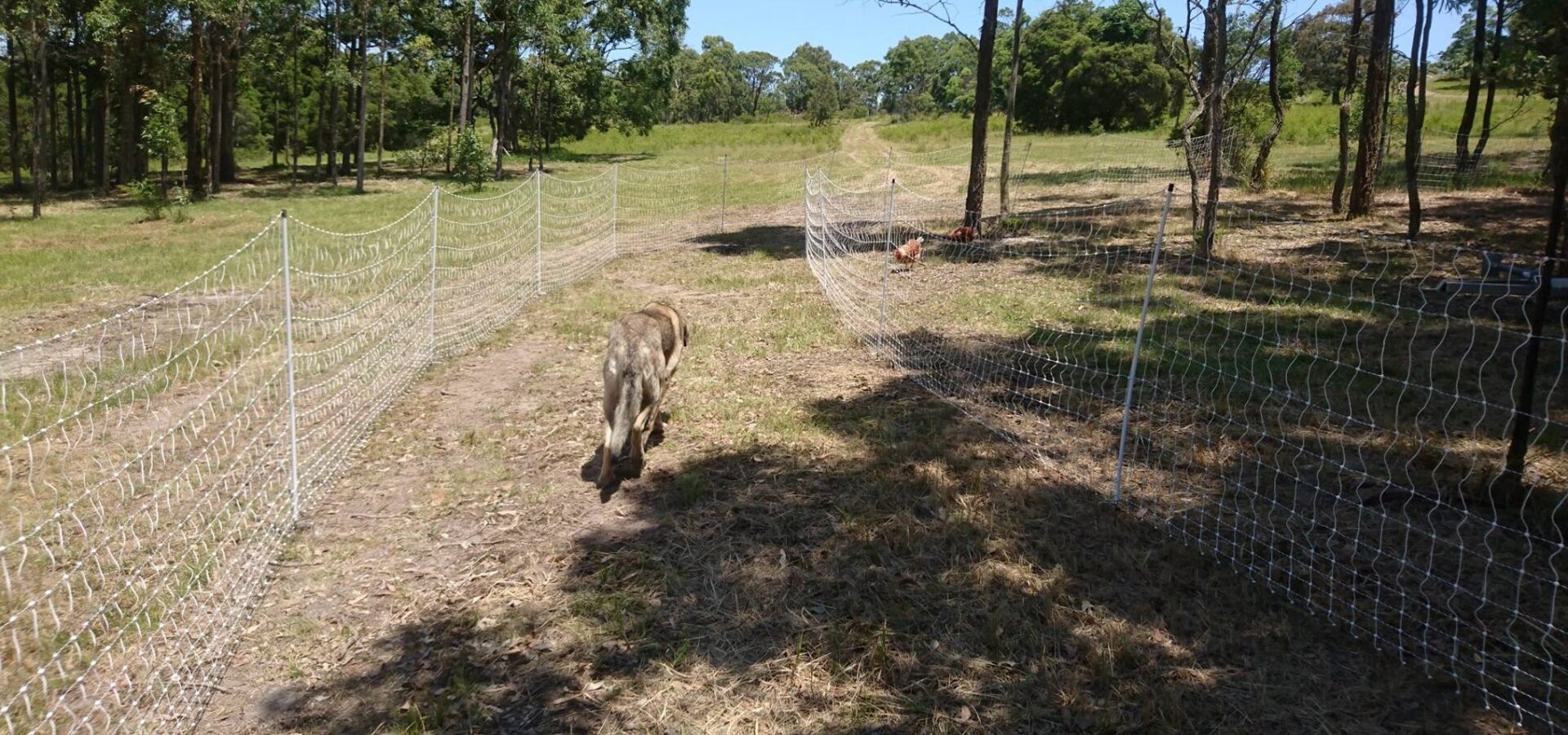
Kawa investigates the “corridor” around the hens’ pen from which she will further her bonding to the hens and at the same time provide a buffer to land-based predators. As a result of the previous efforts to help her to learn to bond to chickens, this process was achieved quickly.
The day Kawa arrived we had a corridor set up with electric net fencing around the hens’ pen. The hens’ pen was approximately 2500 sqm to start with, with a 3m wide corridor of electric netting surrounding the perimeter. Erin was on hand and we introduced Kawa to her new home, at first in the main bigger paddock of 35 acres, then in the corridor. After a couple of hours carefully observing Kawa’s body language and behaviours around the chickens, Erin led Kawa into the pen with the hens and to our delight, we could see Kawa was calm and settled straight away. It was clear that the initial preparation work over previous months had been of value. We continued this separation with supervised access to the hens over the first day, but by the end of the day, we had Kawa off her lead and freely interacting with the hens.
Later that morning we have four eagles attack the hens at the same time! Peter describes it as a scene from a war movie with the eagles dive-bombing like a fighter plane. Previously when this had happened we’d go running in waiving anything we could to scare off the eagles. This kind of worked, but not terribly well. However, this time things were about to change because we had Kawa and before we could jump in the chicken pen and dance around like mad people, Kawa had the situation under control. Consider the scene, 600 hens running frantically for cover (under trees, feeders, their mobile shelter, anything, and four massive eagles swooping in at high speed trying to pick up chickens. It was chaos. Every time an eagle got within a few metres of the ground Kawa was there, right there, between the eagle and the chickens. This went on for maybe two minutes (a long time when a dog is in full battle mode). The eagles left and never returned. To this day we describe that paddock as having a “no-fly zone!”. The eagles will hang around in the sky, but they never, ever fly over the chickens. If they come near the boundary Kawa is there to let them know they’re not welcome.
We do have one large 3,000-acre property to our north. One night we experienced a series of howls from a wild dog some distance away. We knew it was wild as our neighbours’ dogs up and down the valley are quite distinctive and known to Kawa. These howls were met with a single, deep, very authoritative bark from Kawa. A few minutes later the howling stopped. We’ve had zero signs of dog predators since. Like the no-fly zone, it’s as if a bubble exists around our farm with a big sign saying – “stay away!”
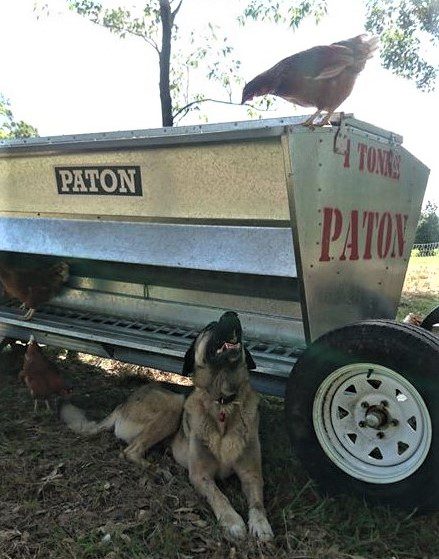
Kawa has developed her own quite distinctive communication with the hens. If she’s resting they will alert her to any threats and she reacts as required. Zero to nuclear has been observed. Kawa’s vigilance and speed in reacting to any threats is quite incredible to watch. So fast, in fact, we’ve never been able to capture it on camera, unfortunately. At other times Kawa will sense a threat and provide a little bark and the hens just carry on with their business. There is an increasing scale of bark from “I’m here, don’t worry”, through to “be alert”, through to “take cover NOW” and the flock knows exactly what Kawa is saying each time.
It hasn’t been all smooth sailing of course. Kawa is one of those LGD’s that likes to periodically check “her patch”, twice a day. Morning and night she’ll do a perimeter walk of the 35 acres, making sure everything is alright, before returning to her girls. The problem we found, however, was that we had wanted Kawa to live within the pen that the hens are in. We keep them in the pen in order to fulfill our regenerative goals via holistic planned grazing. The pen is frequently moved around the farm. We couldn’t have Kawa inside the pen and allow her to do her perimeter checks at the same time. So, we’ve settled on keeping Kawa out of the pen, but within the 35 acres. The eagles, of course, do not know that, so it’s a happy medium. Kawa has her space, the hens have theirs and she looks after both. Erin tells us that each dog is an individual and they will show an observant practitioner how to best utilise that dog’s individual skills and how to adjust their setup accordingly.
Something we panicked about, was how we would introduce Kawa to our two pet Labradors, Maia and Zeus. Again, Erin was on hand that day and we successfully introduced the dogs with the fence in-between using the principles of DESENSITISATION & COUNTER CONDITIONING. The calmness and confidence with which Kawa approached this, was key to winning over the two concerned pet dogs about this ‘intruder.’ We were shocked in fact. Zeus is not a “dogs dog”, having had more obedience training than most “ordinary” dogs he still to this day takes offense to most other dogs when the family is around. He sees himself as our protector in the same way that Kawa’s role is to protect her hens. But it went very well and now whilst they don’t interact within the same space, the two Labs and Kawa will play together with the fence dividing their spaces.

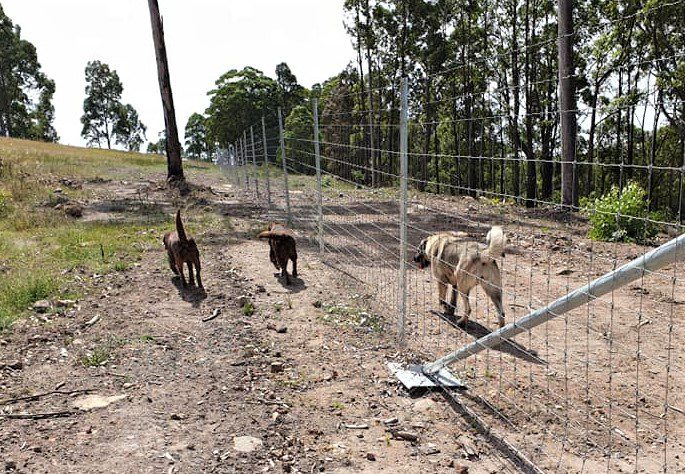
The process of introducing Maia and Zeus, our two pet Labrador Retrievers to Kawa was carried out using “DESENSITISATION & COUNTER CONDITIONING.” As can be seen from the images, it wasn’t long before the dogs would initiate play through the fence that separates them followed by sniffing expeditions in each other’s company.
After a bit over 12 months here, Kawa is well settled into her job and she is thriving in the environment we have provided her. She bonded quickly with the hens and with us as a family. She gets many a tummy and ear rub each day, but remains relatively aloof, being mostly content to spend her time sitting by the hens’ pen making sure all is well in their world. Kawa is an integral part of our team and family, and we could not do what we do without her. She provides protection for the hens and comfort for us knowing that all is well whilst Kawa is on duty.
We have great reverence for all dogs and their amazing bond with humans. We are especially impressed with all working dogs and their incredible talents and abilities. We knew however before we started this process that we didn’t know a thing about LGDs and would need help. Erin has been with us on the journey the whole way and made what we thought could be incredibly stressful situations, stress-free and easy. Erin provides the constant, level-headedness we need and the practical, sensible techniques we can employ to achieve our desired outcomes. As we said, most of this work was with us, the humans, not necessarily the dogs, and it’s been an amazing and humbling experience.
We should note that a lot of the ongoing work after the initial introduction of Kawa and followups have been done by Erin remotely. We upload photos and videos for her to review and she provides guidance to us on how to deal with any situation. Coupled with phone calls we feel we are fully supported to this day. We cannot thank Erin enough for her skill and patience in helping us to establish a key and important part of our farming operation to ensure success.
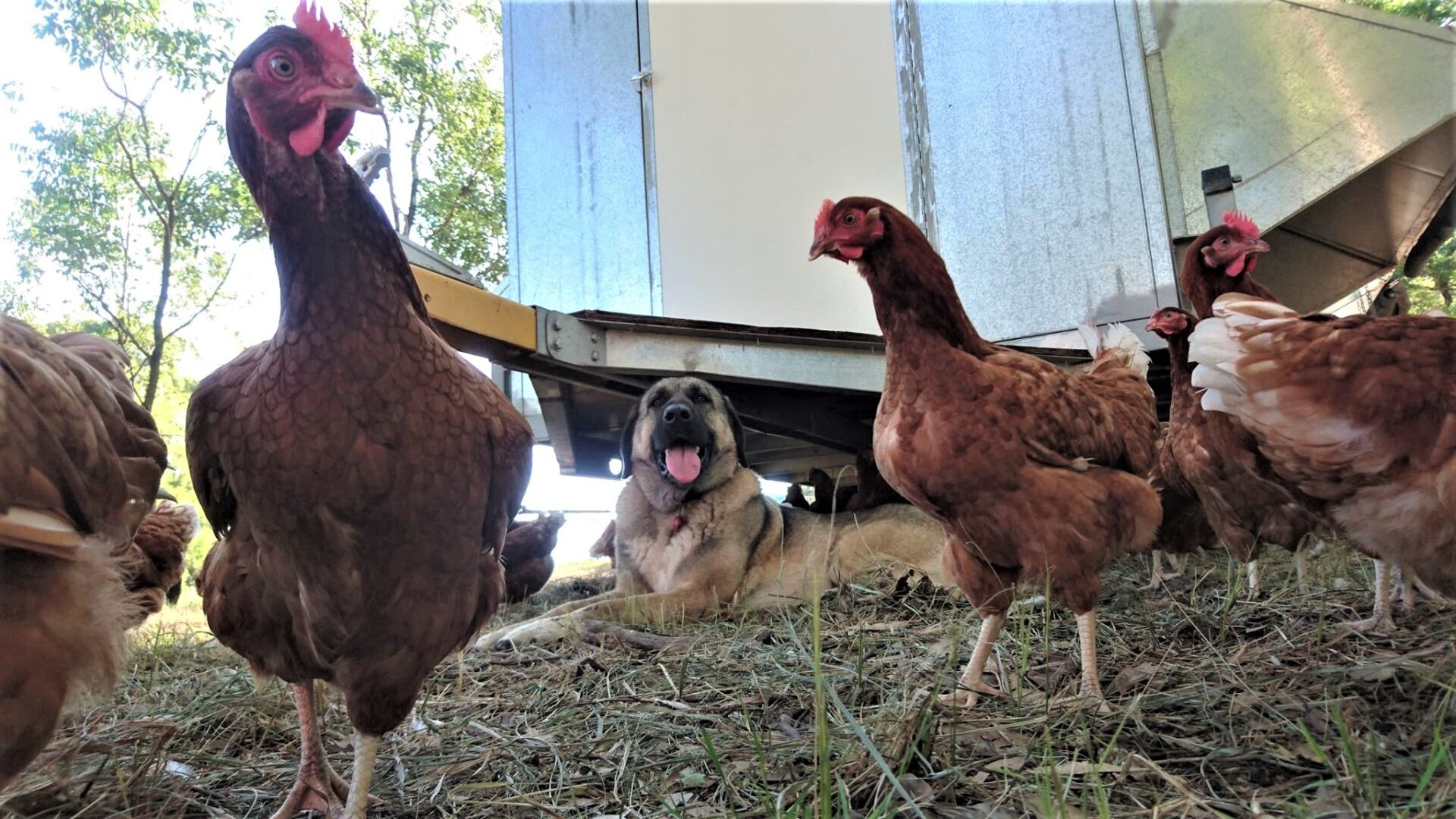
Author: Kapsali Farm – https://www.facebook.com/KapsaliFarm/
Tribocie Anatolian Shepherds – https://www.facebook.com/Tribocie-Anatolian-Shepherd-Dogs-125965560765826/
Photo Credits: – Kapsali Farm & Erin Williams (All Rights Reserved)

